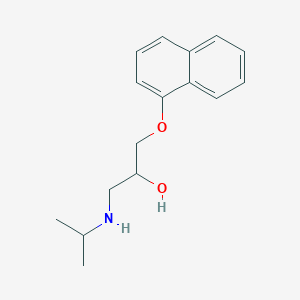Emergency treatment of cardiac arrhythmias
Adult: 1 mg given over 1 minute, may be repeated if necessary every 2 minutes. Max: 10 mg in conscious patients and 5 mg in patients under anaesthesia.
Oral
Phaeochromocytoma
Adult: As conventional tab or oral solution: In combination with an α-blocker: 60 mg daily for 3 days before the surgery. If tumour is unsuitable for surgery, 30 mg/day in divided doses.
Child: As conventional tab or oral solution: 0.25-0.5 mg/kg 3-4 times daily.
Child: As conventional tab or oral solution: 0.25-0.5 mg/kg 3-4 times daily.
Oral
Hypertension
Adult: As conventional tab or oral solution: Initially, 40-80 mg bid, may be increased at weekly intervals according to response. Usual range:160-320 mg daily. Max: 640 mg/day. As extended-release cap: 80 mg once daily.
Oral
Myocardial infarction
Adult: As conventional tab or oral solution: Initiate within 5-21 days of MI, 40 mg 4 times daily for 2-3 days, followed by 80 mg bid.
Oral
Portal hypertension
Adult: As conventional tab or oral solution: Initially, 40 mg bid, may be increased to 80 mg bid depending on heart rate response. As extended release cap: 80 mg once daily, may be increased to 160 mg once daily. Max: 320 mg once daily.
Oral
Prophylaxis of migraine
Adult: As conventional tab or oral solution: Initially, 40 mg bid-tid, may be increased according to response. Usual range: 80-160 mg daily. As extended-release cap: Initially, 80mg once daily, may be increased according to response. Usual effective dose: 160-240 mg once daily.
Child: As conventional tab or oral solution: ≤12 years 10-20 mg bid or tid; >12 years Initially, 40 mg bid or tid, may be increased according to response.
Child: As conventional tab or oral solution: ≤12 years 10-20 mg bid or tid; >12 years Initially, 40 mg bid or tid, may be increased according to response.
Oral
Cardiac arrhythmias
Adult: As conventional tab or oral solution: 10-40 mg 3-4 times daily.
Child: As conventional tab or oral solution: 0.25-0.5 mg/kg 3-4 times daily.
Child: As conventional tab or oral solution: 0.25-0.5 mg/kg 3-4 times daily.
Oral
Essential tremor
Adult: As conventional tab or oral solution: Initially, 40 mg bid-tid, may be increased according to response. Usual range: 80-160 mg daily. As extended-release cap: Initially, 80mg once daily, may be increased according to response. Usual effective dose: 160-240 mg once daily.
Oral
Anxiety
Adult: As conventional tab or oral solution: 40 mg daily, may be increased if necessary to 40 mg bid-tid. As extended release cap: 80 mg once daily.
Oral
Angina pectoris
Adult: As conventional tab or oral solution: Initially, 40 mg bid-tid, may be increased according to response. Usual range: 120-240 mg daily. As extended-release cap: 80mg once daily, may be increased to 160 mg once daily. Max: 320 mg.
Oral
Hypertrophic cardiomyopathy
Adult: As conventional tab or oral solution:10-40 mg 3-4 times daily. As extended-release cap: 80-160 mg once daily.
Oral
Hyperthyroidism
Adult: As conventional tab or oral solution: 10-40 mg 3-4 times daily. As extended release cap: 80 mg once daily, may be increased to 160 mg daily. Max: 240 mg/day.
Child: As conventional tab or oral solution: 0.25-0.5 mg/kg 3-4 times daily.
Child: As conventional tab or oral solution: 0.25-0.5 mg/kg 3-4 times daily.




 Sign Out
Sign Out




